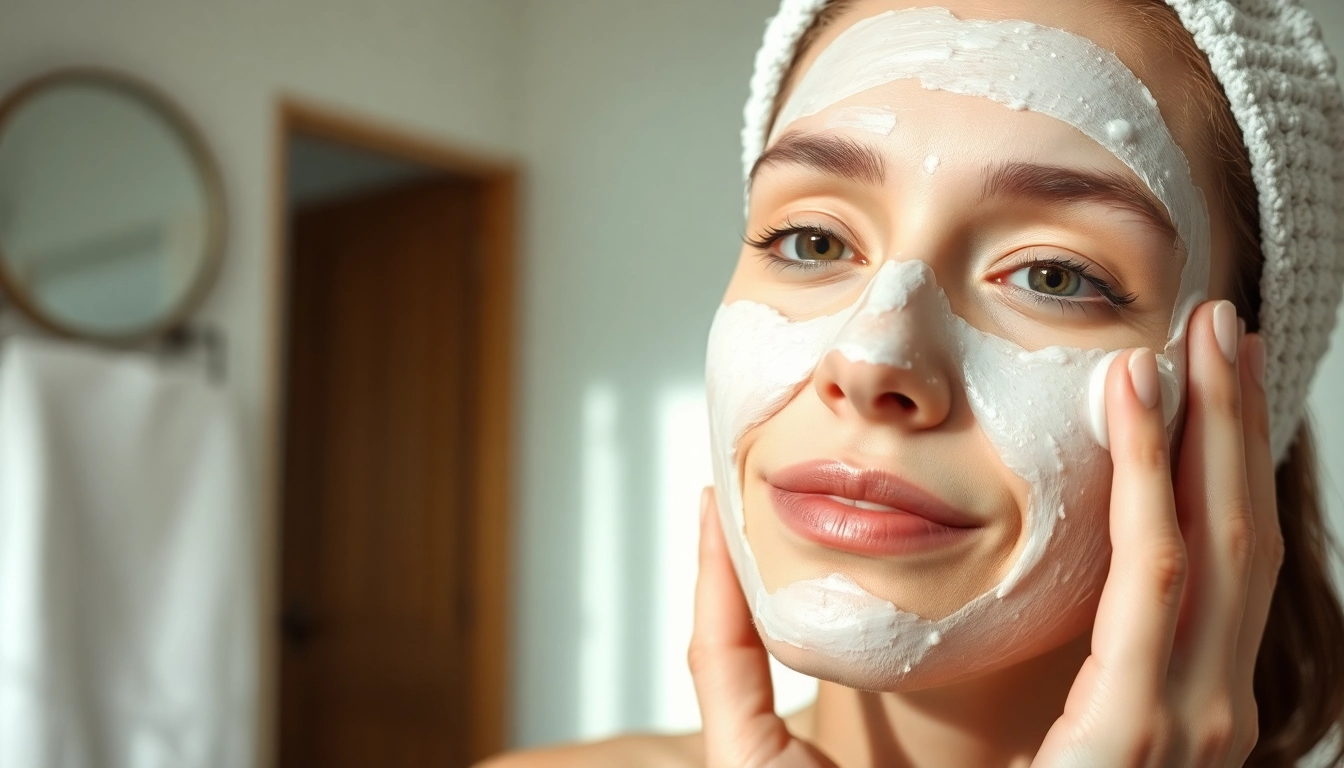
Revitalize Your Skin: Top Benefits of Using a Face Mask for Every Skin Type
Understanding Face Masks: Types and Their Benefits
Face masks have evolved into essential components of modern skincare routines, offering a wide array of benefits that cater to different skin types and concerns. With the multitude of products available, it’s vital to understand the various types of face masks and what they can do for your skin. By incorporating an appropriate face mask into your regimen, you can enhance your skin’s health and appearance significantly.
1. Different Types of Face Masks
Face masks can be broadly categorized into several types, each designed to address specific skin concerns. Here are some of the most common types:
- Cream Masks: These moisturizing masks are rich in emollients and provide a nourishing treatment, perfect for dry or sensitive skin.
- Clay Masks: Best for oily and acne-prone skin, clay masks absorb excess oil and impurities while drawing out toxins.
- Sheet Masks: Infused with serum, these masks deliver concentrated ingredients directly to the skin, making them ideal for a quick hydrating boost.
- Peel-off Masks: These masks offer exfoliation by removing dead skin cells and impurities once peeled away. They can improve skin texture and clarity.
- Exfoliating Masks: Often containing acids or enzymes, these masks gently exfoliate the skin, promoting cell turnover and revealing a brighter complexion.
- Sleeping Masks: Designed to be worn overnight, these masks work while you sleep, providing deep hydration and rejuvenating the skin.
2. Benefits of Each Face Mask Type
Understanding the benefits of each type can help you make informed choices based on your skin type:
- Cream Masks: They not only hydrate but also create a barrier that locks in moisture, making them ideal for combating dryness.
- Clay Masks: Beyond oil absorption, they can also help reduce the appearance of pores and improve overall skin clarity.
- Sheet Masks: Their easy application means they can provide a quick treatment for on-the-go hydration and radiance.
- Peel-off Masks: They offer immediate smoothness and luminescence, thanks to their exfoliating properties.
- Exfoliating Masks: They can significantly improve skin tone and texture, making the skin appear youthful and radiant.
- Sleeping Masks: Their unique formulation allows your skin to absorb active ingredients deeply while you rest, maximizing skin benefits.
3. How to Choose the Right Face Mask for Your Skin
Choosing the right face mask involves matching the product to your specific skin concerns:
- Identify Your Skin Type: Understanding whether your skin is oily, dry, combination, or sensitive is crucial. For instance, oily skin may benefit from clay masks, while dry skin may require hydrating cream masks.
- Assess Your Skin Concerns: Do you suffer from acne, aging, pigmentation, or dehydration? Targeted masks can provide enhanced results for specific issues.
- Check Ingredients: Look for masks that contain beneficial ingredients suited to your skin concerns, like hyaluronic acid for hydration, charcoal for detoxification, or vitamin C for brightness.
How Face Masks Enhance Your Skincare Routine
Incorporating face masks into your skincare regimen can significantly enhance its overall effectiveness and results. Here’s how:
1. Complementing Your Regular Skincare Products
Face masks are designed to provide additional benefits beyond what your regular skincare routine offers. By using a face mask after cleansing, you allow potent ingredients to penetrate deeper into the skin, boosting the efficacy of serums and moisturizers that follow. For example, a hydrating mask can prep your skin to better absorb a serum designed for anti-aging, enhancing its effects.
2. The Importance of Skin Preparation Before a Face Mask
Before applying a face mask, proper skin preparation is key to maximizing its benefits. Start with a gentle cleanser to remove makeup and impurities. Following cleansing, consider using a toner to balance your skin’s pH and further prep it for mask application. Exfoliating once or twice a week can also help in removing dead skin cells, allowing ingredients in the mask to penetrate better for more visible results.
3. Common Mistakes When Using Face Masks
While face masks offer numerous benefits, many people make common mistakes that can hinder results:
- Overusing Masks: Using masks too frequently can irritate the skin, especially for those with sensitive skin. It’s best to follow the manufacturer’s recommendations for frequency.
- Not Following Directions: Timing and application methods are critical. Always adhere to the recommended time and avoid applying too thickly.
- Skipping Moisturizer: After removing a mask, always follow up with a moisturizer to lock in hydration and nourishment.
DIY Face Masks: Natural Ingredients You Can Use
For those who enjoy customizing their skincare, DIY face masks offer a fun and economical alternative. Using natural ingredients can provide a wealth of benefits tailored to your skin’s specific needs.
1. Popular Natural Ingredients for Face Masks
Some popular natural ingredients that can be effective in DIY masks include:
- Honey: Known for its antibacterial and moisturizing properties, honey is an excellent ingredient for soothing and nourishing the skin.
- Aloe Vera: Renowned for its calming effect, aloe vera can hydrate, soothe, and heal irritated skin.
- Oatmeal: A gentle exfoliant, oatmeal can help reduce inflammation and itchiness while providing moisture.
- Coconut Oil: Rich in fatty acids, coconut oil can deeply hydrate the skin, making it a staple in many DIY masks.
- Yogurt: Containing lactic acid, yogurt can help exfoliate and moisturize, also brightening the skin.
2. Step-by-Step Guide for DIY Face Masks
Here’s a simple guide to create your own face mask at home:
- Choose Your Base: Depending on your skin type, select a base like yogurt for oily skin or honey for dry skin.
- Add Active Ingredients: Incorporate ingredients like mashed avocado for hydration or turmeric for brightening.
- Mix Well: Combine your ingredients into a smooth paste.
- Apply to Clean Skin: Use a brush or your fingers to apply the mask evenly, avoiding the eye area.
- Leave On: Allow the mask to sit for 10-20 minutes, then rinse with cool water.
3. Safety Tips and Considerations
While DIY masks are generally safe, consider these tips:
- Patch Test: Always perform a patch test on a small area of your skin to rule out any allergic reactions.
- Use Fresh Ingredients: To avoid bacteria growth, use fresh ingredients and store them in the refrigerator if not used immediately.
- Consult with Professionals: If you have specific skin issues, consult a dermatologist before trying new ingredients.
Face Mask Application Techniques for Best Results
Mastering the application of face masks can greatly affect the overall results you achieve. Let’s explore the best techniques for application:
1. How to Properly Apply a Face Mask
Applying a mask correctly sets the stage for effective results:
- Start with Clean Skin: Ensure your face is free from makeup and impurities.
- Use the Right Tools: Finger application can work, but brushes or spatulas promote even distribution.
- Apply Evenly: Use gentle, upward strokes, avoiding the eye and mouth area.
2. Timing: How Long to Keep a Face Mask On
The timing for keeping a mask on varies widely:
- Follow Instructions: Always adhere to the package instructions for the specific mask you are using, typically ranging from 10 to 30 minutes.
- Monitor Skin Sensation: If you experience irritation or discomfort, remove the mask immediately, even if it hasn’t reached the time limit.
3. Post-Mask Skincare: What to Do After
What you do after removing your mask is just as critical:
- Rinse Thoroughly: Use cool water to remove the mask completely, which helps to close the pores.
- Moisturize: Follow up with a moisturizer to seal in hydration and enhance the effects of the mask.
- Incorporate a Serum: This is a great time to apply a serum that addresses your specific skin concerns, taking advantage of your skin’s receptivity post-mask.
Measuring the Effectiveness of Your Face Mask
Understanding how to measure the effectiveness of your face mask will help in determining if it is right for your skin and what adjustments you may need to make.
1. Signs That Your Face Mask is Working
Being able to identify the signs of an effective mask can help guide your skincare choices:
- Improved Texture: After using a mask, your skin may feel smoother and look more even.
- Hydration: A noticeable increase in moisture levels can indicate that the mask is doing its job.
- Brightening Effect: Many masks improve brightness, leaving a refreshed appearance.
2. How to Incorporate Feedback into Your Routine
Assessing your experience with different masks can inform future usage:
- Journal Your Results: Keep a journal to document your results and how your skin responds to various masks.
- Adjust Based on Feedback: If a certain mask works well, you might want to use it more frequently or pair it with compatible products.
3. When to Seek Professional Advice
If you’re unsure about which masks to use or experience negative reactions, consulting a dermatologist can provide expert guidance and recommendations tailored to your skin type and concerns.



